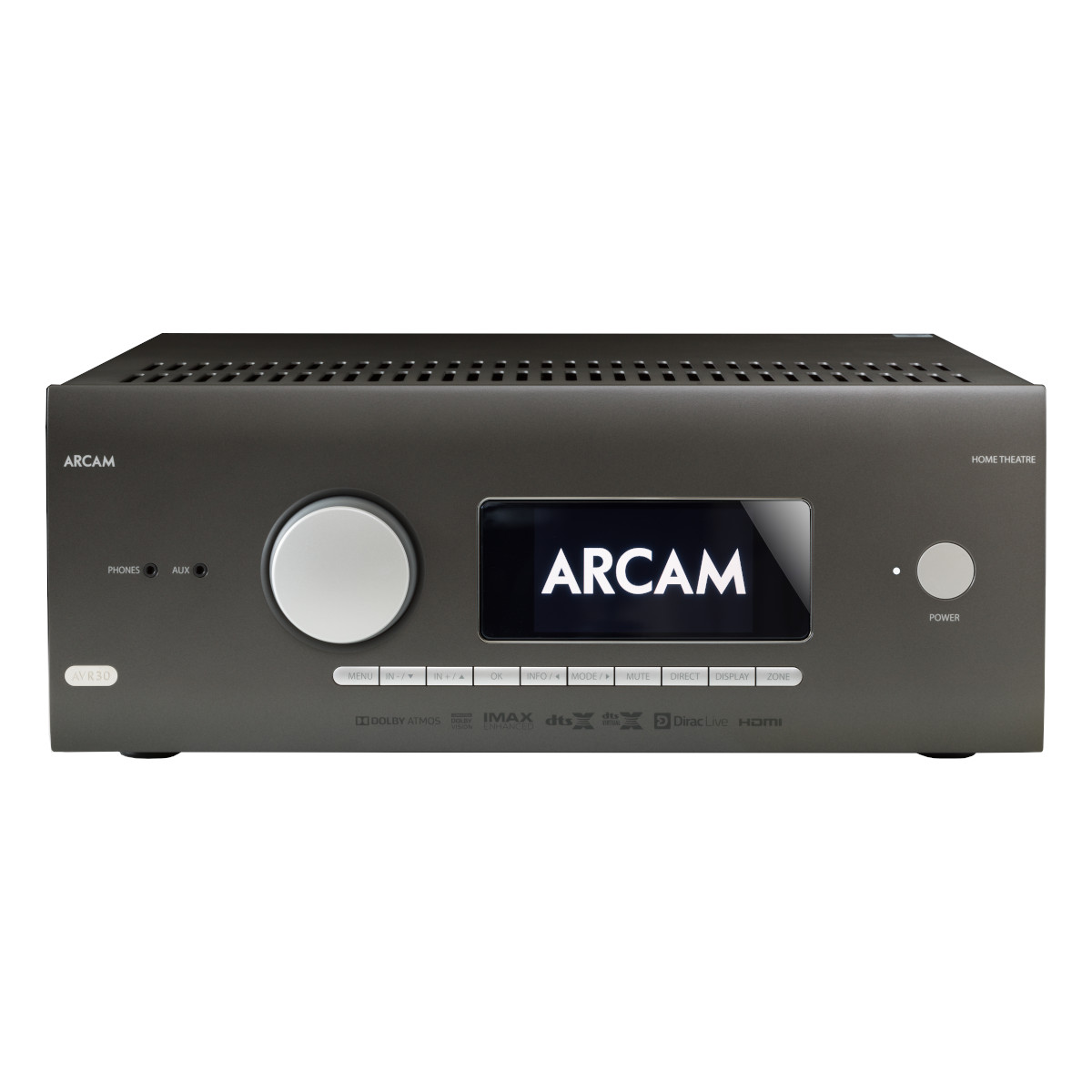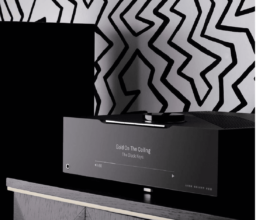ARCAM AVR30 Review – Full immersion is the objective
Steve Withers swaps FMJ for HDA and finally turns into an object-based nutter as he immerses himself in 16 channels. Read our ARCAM AVR30 Review.
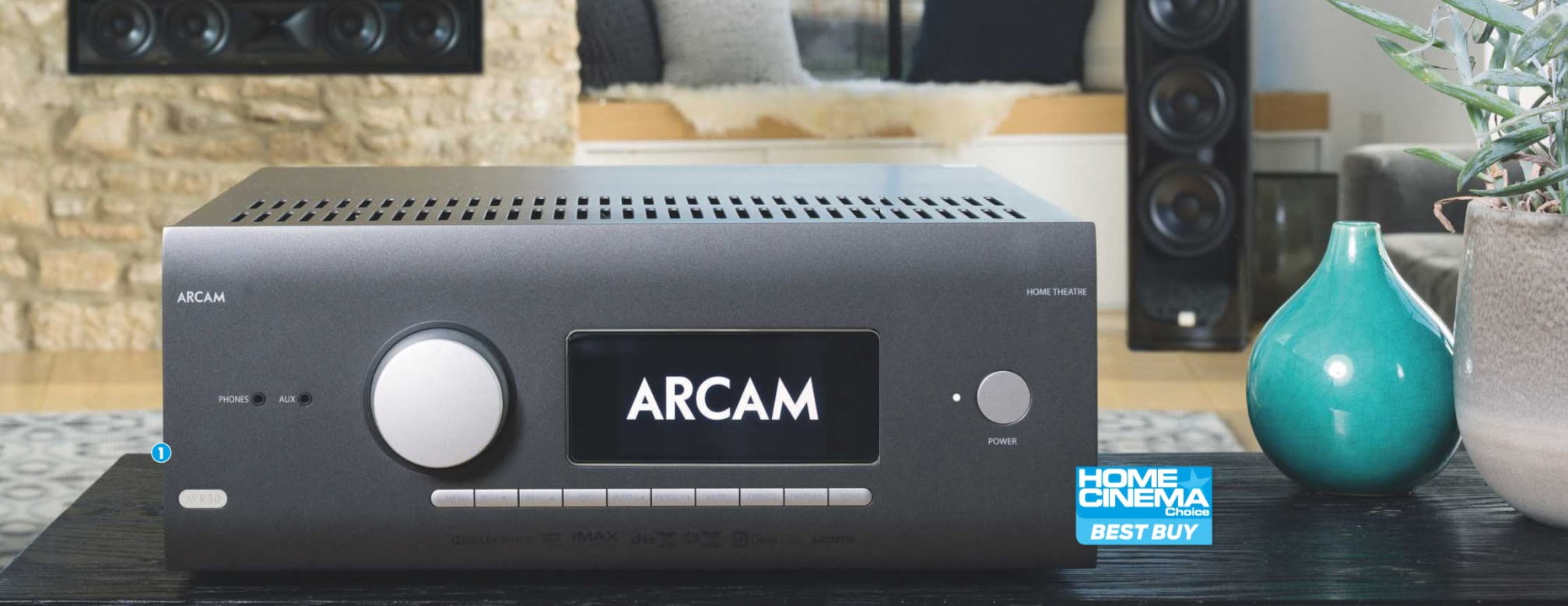
Arcam’s new lineup of AV models is finally here, adding three seven-channel receivers and a 16-channel processor to its High Definition Audio (HDA) range. HDA, for those who keep an eye on acronyms, replaces the outgoing, and cooler named, Full Metal Jacket (FMJ) series, bringing with it a number of changes – some more apparent than others.
The most obvious difference is cosmetic, with a ‘lifestylefriendly’ design replacing the more traditional – and some would say ‘industrial’ – Arcam look. To be honest, the two-tone styling of the silver buttons and volume dial looks a bit odd on a high-cost receiver, so the redesign might not be a complete success. On the plus side, a full-colour LCD screen replaces the previous green dot-matrix display, and only die-hard retro freaks will lament its passing.
Aesthetics aside, the real differences are internal, with the new models supporting Dolby Atmos, DTS:X, IMAX
Position: Only Class G model in HDA lineup
Peers: Marantz SR8015; NAD T 778; Denon AVC-X8500H
Enhanced and Auro-3D right out of the box – with the latter being new to Arcam. While the receivers are limited to seven channels of built-in amplification, the processing can handle up to 16, which means Atmos at 15.1 and Auro-3D at 13.1, although Arcam’s implementation of DTS:X is still limited to 11.1 channels.
The other big change is evidenced by three huge antennae at the rear: the HDA lineup sports built-in Bluetooth and Wi-Fi, with support for Google Chromecast and Apple AirPlay 2. So no more tripping over Ethernet cables just to stream content, run Dirac Live or update the firmware.
In terms of other new features, the receivers and processor still have a 7-in, 3-out HDMI stage with 4K HDR passthrough, but now add support for eARC, allowing lossless audio to be sent back from a compatible TV. The continued use of HDMI 2.0b – rather than 2.1 – does limit future-proofing, but Arcam has never been a brand to ring all bells and whistles.
The AVR30 reviewed here is the flagship HDA receiver. Along with the features already mentioned, it packs ESS 9026PRO audiophile DACs, Class G amplification with a toroidal transformer, and Dirac Live room correction.
The second-tier AVR20 is essentially the same but switches the more expensive Class G for traditional Class AB amplification. If you don’t need 16 channels of processing there’s the entry-level AVR10, which also uses Class AB amps but is limited to 7.1.4 decoding on all formats. The AV40, meanwhile, is a 16-channel processor that swaps the AVR30’s onboard power for balanced XLR outputs.
You might wonder why the AVR30 only has seven powered channels but can decode up to 16. Arcam believes it’s better to offer high-quality Class G grunt, rather than compromise performance by cramming in more amp modules. For those wanting extra channels, the company sells its PA410 power amp with four channels of Class AB, or the PA720 with seven channels of Class G welly.
Arcam has been using Class G on some of its amps since 2009. Intended to ape the efficiency and low power consumption of Class D, without sacrificing audio quality, it uses a conventional output stage fed from two (or more) power supplies that are introduced according to signal
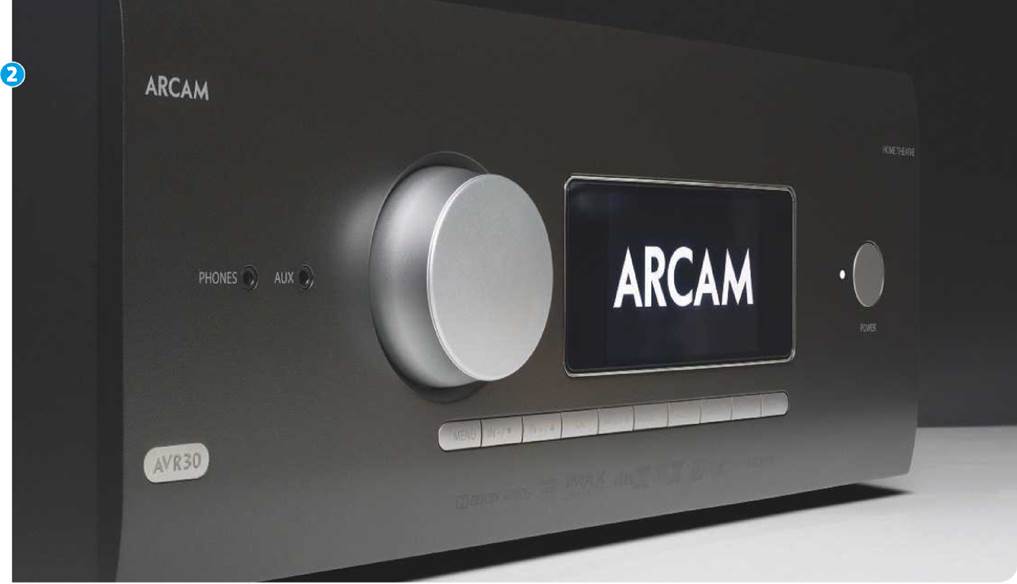
demand; the higher PSU rail(s) are only switched in once the audio output rises above a certain level.
An Arcam AVR850 previously graced my reference system, so I’m familiar with the AVR30’s immediate predecessor and, cosmetics and processing aside, the two aren’t wildly different.
The built-in Wi-Fi is very welcome. It’s a cinch to connect using Chromecast or AirPlay, and makes streaming music painless. It’s also useful for setup because surprisingly the new model doesn’t have an onscreen menu – you can either use the LCD display on the unit itself, or a web-based interface. The only onscreen info relates to changes in volume or the selected source.
The remote control remains the same, and that includes the annoying quirk where you have to remember to press the ‘Amp’ button after selecting an input. You also still can’t reassign the internal amplification, although you do have greater flexibility with the outputs for channels 13 to 16. These can be assigned for front width, extra height or additional subwoofer channels.
The receiver is supplied with a calibrated microphone and supports the latest version of Dirac Live, allowing you to measure the speakers in your system and correct for your room’s acoustic aberrations. You can customise the target correction filters, group speakers together to create system-wide crossovers, and create up to three profiles for different content or room conditions. It’s impressively flexible, and its impact can be considerable.
For full immersion I used a 9.2.6 system based around M&K Sound speakers and subs, with an Emotiva XPA-11 power amp to drive the additional eight channels.
And it was fantastic…
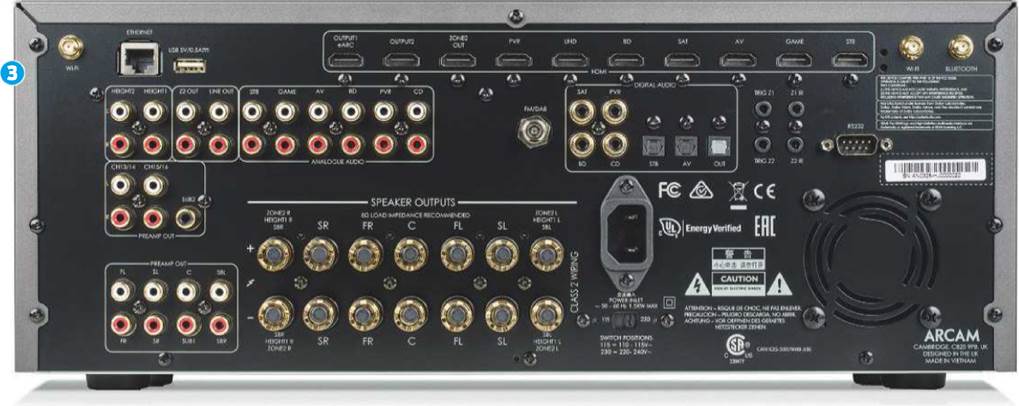
Regardless of your chosen speaker configuration this receiver is capable of a clean yet powerful delivery. The soundstage is balanced, with all the energy, poise and responsiveness I have come to expect from Class G. The dynamic range is also phenomenal, going from kitten’s breath to eardrum-shattering in an instant.
With the Arcam running a 5.1.2-channel config at first, I popped in my trusty House of Flying Daggers Blu-ray. With the ‘drum dance’ sequence, the AVR30’s soundstage felt incredibly tight, with exquisite timing.
‘The soundstage is balanced, with all the energy, poise and responsiveness I have come to expect from Class G’
All good, but it was time to get serious. This was my first opportunity to run a 9.2.6 setup in my theatre, and I was keen to discover if those extra speakers would actually make a noticeable difference.
As soon as I selected the Amaze trailer on Dolby’s Atmos demo disc I had my answer, and it was a resounding yes. This object-based mix is designed to showcase the strengths of the format, and from bees buzzing around behind me to the bird that flies across the room, it proved deliciously immersive. Thunder rumbled overhead, and rain lashed down all around in a soundfield that was articulate and utterly believable, the Arcam AVR painting a sonic picture rather than simply throwing effects around. And the deep bass of the thunder was weighty and controlled, underscoring the rest of the system rather than swamping it.
Emboldened by this, I reached for Unbroken (Blu-ray), a film with remarkable sound design. I’ve watched the opening bombing run on numerous systems, and it was spot on here; an exercise in skill and precision from the sound of the propellor engines moving overhead, to the wind whistling around the crews in their rickety bombers.
And 16 channels results in a horizon-wide soundstage with dramatic sense of three-dimensional space. As the US bombers approached their target, flak ripped through the air and the AVR30 pinpointed each explosion, while the subs gave them an added kick. There was an equally rewarding sub-sonic rumble as the bombs hit their target. The Japanese Zero attack was a maelstrom of front-to- back and side-to-side effects steering.
It was a similar experience with the Atmos mix for Midway (4K Blu-ray). Planes swarm the soundfield during the titular battle, and the addition of further overhead and front wide speakers allowed the receiver to pan effects from channel to channel without missing a beat. It called to mind the performance of Lyngdorf’s MP-60 processor [see HCC #311], and that costs three times as much.
The addition of Auro-3D to the Arcam playbook won’t matter to most buyers, as the sound format utilises a different speaker layout to the 3D sound norm, and available native content is minimal. I still gave my Pixels Blu-ray a whirl, to check decoding, and it sounded sublime,
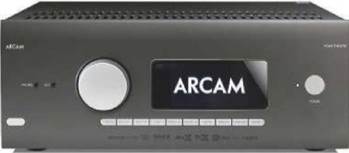
even through my Atmos setup. The Caterpillar videogame fight scene makes frequent use of Auro-3D’s top layer, and sounds often emanated from above, swirling around the room as alien attackers were blasted out of the sky.
Bad Boys for Life (UHD BD) has an IMAX Enhanced DTS:X soundtrack, and the AVR30 detected the correct audio format and got on with wowing me with yet another all-encompassing sonic experience. The soundstage is big and bold, the music suitably funky and the object-based mix is an amped-up paean to ballistic destruction.
This is an amp that’s poised and precise, but doesn’t mind getting its hands dirty. Adrenaline-junkies will be delighted. In the film’s final shoot-out, which takes place in an abandoned hotel lobby circled by a staircase, gunfire blasted overhead, explosions echoed up the walls and as the stained-glass roof shattered, shards rained down from above. It was totally immersive and undeniably exciting.
The AVR30 takes the AV receiver concept to the next level with a 16-channel processing performance that gives far costlier systems a run for their money. It might ‘only’ have seven channels of amplification, but its Class G power delivers the goods. Add the extra amps necessary to run a full 16-channel layout, and use Dirac to lock everything into place, and the results are simply spellbinding. The lack of HDMI 2.1 is disappointing for a high-end receiver with a five-year life-cycle, and there’s no DTS:X Pro support, but otherwise this is hard to fault and an appealing upgrade on the FMJ range
DOLBY ATMOS: Yes DTS:X: Yes IMAX ENHANCED: Yes MULTICHANNEL INPUT: No MULTICHANNEL PRE-OUT: Yes. 15-channel MULTICHANNEL OUTPUT (CLAIMED): 7 x 100W (into 8 ohms) MULTIROOM: Yes. Second AV zone AV INPUTS: 7 x digital audio (3 x optical and 4 x coaxial); 6 x analogue stereo HDMI: Yes. 7 x inputs; 3 x outputs VIDEO UPSCALING: No DIMENSIONS: 433(w) x 171(h) 425(d)mm WEIGHT: 18.1kg
FEATURES: Class G amplifier; Auro-3D support; 2 x 8ch ESS 9026PRO DACs; built-in Wi-Fi and Bluetooth; Chromecast and AirPlay 2 support; web-based setup and control; Dirac Live room correction; FM/DAB tuner; calibrated microphone; IR input; 12V trigger; Ethernet; USB port; RS232 serial connector; MusicLife iOS UPnP and control app; HDMI 2.0b; HDR10, HLG, HDR10+ and Dolby Vision passthrough
PARTNER WITH
EMOTIVA XPA 11 GEN3: There are few single-box power amps around able to add the juice required for a 16-channel setup via the AVR30. This Class H 11-channel model from the US audio brand is a bargain.
When you purchase through links on our site, I may earn an affiliate commission. Here’s how it works.
Arcam AVR30 AV Receiver Unboxing
Arcam's highly anticipated AVR30 employs Class G amplification and offers a16-channel surround solution with all the latest CODECs from Dolby, DTS and ...


